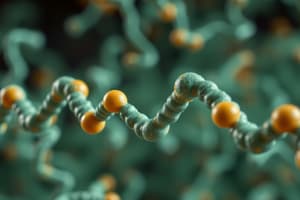Podcast
Questions and Answers
What are the monomers and polymers of carbohydrates, lipids, proteins, and nucleic acids?
What are the monomers and polymers of carbohydrates, lipids, proteins, and nucleic acids?
Monomers: Carbohydrates - monosaccharides, Lipids - glycerol and fatty acids, Nucleic acids - nucleotides, Proteins - amino acids. Polymers: Carbohydrates, Lipids, Proteins, Nucleic acids.
What are the major functions of each macromolecule?
What are the major functions of each macromolecule?
Carbohydrates - provide energy and regulate blood glucose; Lipids - store energy and help form cell membranes; Proteins - required for structure, function, and regulation of body tissues and organs; Nucleic Acids - DNA and RNA inherited from parents.
Provide an example for each type of macromolecule.
Provide an example for each type of macromolecule.
Carbohydrates - starch, sugar, cellulose, glucose; Lipids - triglycerides, steroids; Proteins - eggs, meat, peroxidase, nuts, cheese; Nucleic Acids - DNA, RNA.
Compare the relative energy storage of carbohydrates, lipids, and proteins.
Compare the relative energy storage of carbohydrates, lipids, and proteins.
In what order does the body consume carbohydrates, lipids, and proteins for energy?
In what order does the body consume carbohydrates, lipids, and proteins for energy?
What are macromolecules?
What are macromolecules?
What are carbohydrates broken down to?
What are carbohydrates broken down to?
What are monosaccharides?
What are monosaccharides?
What are polysaccharides?
What are polysaccharides?
What are lipids?
What are lipids?
What is glycerol?
What is glycerol?
What are fatty acids?
What are fatty acids?
What are proteins?
What are proteins?
What are amino acids?
What are amino acids?
What are nucleic acids?
What are nucleic acids?
What is a nucleotide?
What is a nucleotide?
Flashcards are hidden until you start studying
Study Notes
Macromolecules Overview
- Macromolecules are large organic molecules essential for life.
- They include carbohydrates, lipids, proteins, and nucleic acids.
Monomers and Polymers
- Carbohydrates: Monosaccharides (e.g., glucose); Polymers: starch, cellulose.
- Lipids: Glycerol and fatty acids; Polymers: triglycerides, steroids.
- Proteins: Amino acids; Polymers: polypeptides, proteins.
- Nucleic acids: Nucleotides; Polymers: DNA, RNA.
Functions of Macromolecules
- Carbohydrates: Provide energy and regulate blood glucose levels (e.g., glucose).
- Lipids: Store energy and form cell membranes (e.g., triglycerides).
- Proteins: Essential for structure, function, and regulation in tissues (e.g., enzymes like peroxidase).
- Nucleic Acids: Store and transfer genetic information (e.g., DNA, RNA).
Energy Storage Comparison
- Carbohydrates: 4 calories/milligram.
- Lipids: 9 calories/milligram (highest energy source).
- Proteins: 4 calories/milligram.
Energy Consumption Order
- The body uses carbohydrates first for quick energy, then lipids for long-term energy, and lastly proteins for energy when others are unavailable.
- Digestion begins with carbohydrates in the mouth, followed by fats in the small intestine, and proteins in the stomach.
Diet and Exercise for Weight Loss
- Focus on a balanced intake of carbohydrates for energy, healthy fats for satiety, and proteins for muscle maintenance.
- Regular exercise can enhance fat utilization and overall health.
Types of Carbohydrates
- Monosaccharides: Glucose, fructose, galactose.
- Polysaccharides: Large macromolecules formed from monosaccharides (e.g., starch).
Lipids Characteristics
- Energy-rich compounds include fats, oils, and waxes.
- Composed of carbon, hydrogen, and oxygen.
Building Blocks
- Glycerol: Combines with fatty acids to form lipids.
- Fatty acids: The basic building blocks of lipids.
- Amino acids: The building blocks of proteins; crucial for cell and tissue maintenance.
Nucleic Acids
- Composed of nucleotides, which consist of a five-carbon sugar, nitrogenous base, and phosphate group.
- Key for genetic information storage and transfer.
Studying That Suits You
Use AI to generate personalized quizzes and flashcards to suit your learning preferences.




